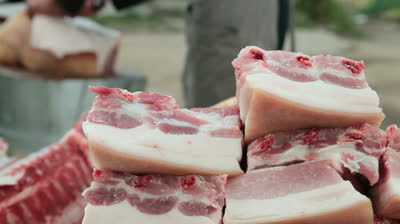In the Philippines, botcha or double dead meat refers to the meat of animals—commonly chicken, beef, or pork—that died due to illness but was still butchered and sold in markets. This type of meat is hazardous to health and can cause serious illnesses when consumed.
In Metro Manila, areas such as Balintawak Market, Divisoria, and Pasay Market are known hotspots for botcha sales. Consumers are advised to be vigilant and cautious when purchasing meat from these locations.

How to Identify Double Dead Meat
It is crucial to recognize the signs of botcha to avoid potential health risks. Here are some indicators to watch for:
- Pale color. Meat from animals that died of disease often has a noticeably pale color compared to fresh meat. It may also exhibit greenish, grayish, or even blackish hues if the animal has been dead for an extended period.
- Foul odor. Botcha emits a distinct bad smell due to bacterial activity in the carcass. This odor is usually the first warning sign of meat contamination.
- Cold and stiff texture due to ice. Vendors often freeze botcha to disguise its undesirable qualities. If the meat feels unnaturally cold or hard as though freshly removed from a freezer, it may be double dead.
- Unclean skin with hair or feathers. Animals that died before slaughter are more difficult to process. Hair or feathers are often still attached to the meat, indicating improper cleaning.
- Low price. Double dead meat is often sold at significantly reduced prices because it is harder to sell. Unusually cheap meat is a red flag that warrants closer inspection.
Health Risks of Consuming Double Dead Meat
The Department of Health warns that consuming botcha poses serious health risks due to bacteria and other harmful microorganisms that quickly invade the meat after the animal’s death. Some potential health problems include:
- Food poisoning. Symptoms include nausea, vomiting, and severe abdominal pain.
- Diarrhea. Contaminated meat can cause gastrointestinal distress, leading to dehydration and weakness.
- Death. In severe cases, botulism or other life-threatening conditions may occur due to consuming highly contaminated meat.
Characteristics of Fresh Meat
To ensure food safety, buyers should be familiar with the attributes of fresh, high-quality meat:
- Bright red color. Fresh meat is vibrant and uniform in color.
- No foul odor. It should have a neutral or slightly sweet smell, characteristic of freshly butchered meat.
- Soft texture. Fresh meat feels tender and moist, not overly hard or frozen.
- Clean appearance. There should be no hair, feathers, or other residues left on the meat.
- Reasonable price. The price should align with the market rates set by the Department of Trade and Industry (DTI).
Penalties for Selling Double Dead Meat
The sale of botcha is strictly prohibited under the Consumer Act of the Philippines. Violators face:
- Up to five years of imprisonment
- Fines ranging from ₱5,000 to ₱10,000
If you encounter botcha in the market, report it immediately to the authorities. Protecting public health starts with holding those who sell unsafe meat accountable.
Awareness of botcha and its risks is essential to maintaining food safety. By knowing how to identify double dead meat and understanding its dangers, consumers can protect themselves and their families from potential health issues. Always purchase meat from trusted sources and report suspicious vendors to ensure a safer marketplace for everyone.


